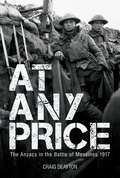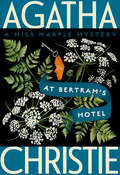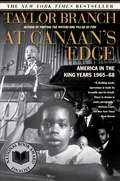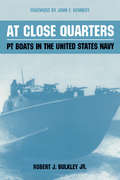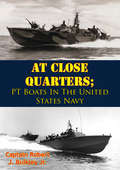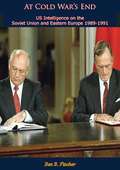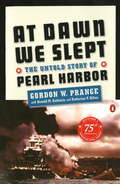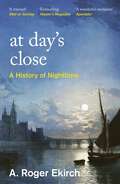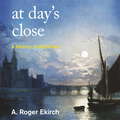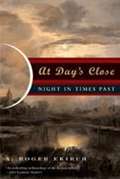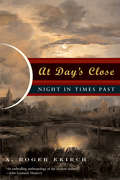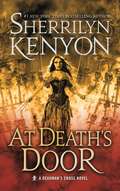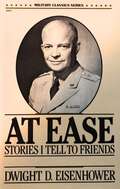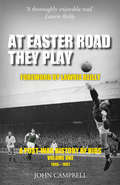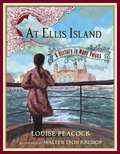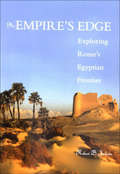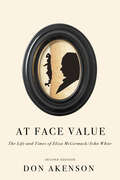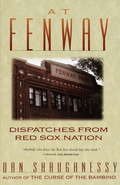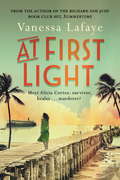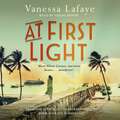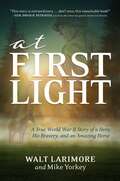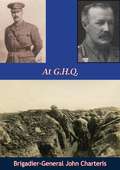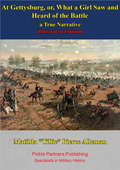- Table View
- List View
At Any Price: The ANZACS at the Battle of Messines 1917
by Craig DeaytonThe enemy must not get the Messines Ridge at any price… So read the orders to German troops defending the vital high ground south of Ypres. On 7 June 1917, the British Second Army launched its attack with an opening like no other. In the largest secret operation of the First World War, British and Commonwealth mining companies placed over a million pounds of explosive beneath the German front-line positions in 19 giant mines which erupted like a volcano. This was just the beginning. By the end of that brilliant summer&’s day, one of the strongest positions on the Western Front had fallen in the greatest British victory in three long years of war. For the ANZACs, who comprised one third of the triumphant Second Army, it was their most significant achievement to that point; for the men of the New Zealand Division, it would be their finest hour. It is difficult to overstate the importance of Messines for the Australians, whose first two years of war had represented an almost unending catalogue of disaster. This was both the first real victory for the AIF and the first test in senior command for Major General John Monash, who commanded the newly formed 3rd Division. Messines was a baptism of fire for the 3rd Division which came into the line alongside the battle-scarred 4th Australian Division, badly mauled at Bullecourt just six weeks earlier. The fighting at Messines would descend into unimaginable savagery, a lethal and sometimes hand-to-hand affair of bayonets, clubs, bombs and incessant machine-gun fire, described by one Australian as &‘72 hours of Hell&’. After their string of bloody defeats over 1915 and 1916, Messines would prove the ultimate test for the Australians.
At Bertram's Hotel: A Miss Marple Mystery (Miss Marple Mysteries #10)
by Agatha ChristieAt Bertram’s Hotel the intrepid Miss Marple, on holiday in London, must solve a deadly mystery at the end of a chain of very violent events.An old-fashioned London hotel is not quite as reputable as it makes out to be.…When Miss Marple comes up from the country for a holiday in London, she finds what she’s looking for at Bertram’s Hotel: traditional decor, impeccable service, and an unmistakable atmosphere of danger behind the highly-polished veneer. Yet, not even Miss Marple can foresee the violent chain of events set in motion when an eccentric guest makes his way to the airport on the wrong day.…
At Canaan's Edge: America in the King Years, 1965-68
by Taylor Branch<P>At Canaan's Edge concludes America in the King Years, a three-volume history that will endure as a masterpiece of storytelling on American race, violence, and democracy. Pulitzer Prize-winner and bestselling author Taylor Branch makes clear in this magisterial account of the civil rights movement that Martin Luther King, Jr., earned a place next to James Madison and Abraham Lincoln in the pantheon of American history. <P>In At Canaan's Edge, King and his movement stand at the zenith of America's defining story, one decade into an epic struggle for the promises of democracy. Branch opens with the authorities' violent suppression of a voting-rights march in Alabama on March 7, 1965. The quest to cross Selma's Edmund Pettus Bridge engages the conscience of the world, strains the civil rights coalition, and embroils King in negotiations with all three branches of the U.S. government. <P>The marches from Selma coincide with the first landing of large U.S. combat units in South Vietnam. The escalation of the war severs the cooperation of King and President Lyndon Johnson after a collaboration that culminated in the landmark 1965 Voting Rights Act. <P>After Selma, young pilgrims led by Stokely Carmichael take the movement into adjacent Lowndes County, Alabama, where not a single member of the black majority has tried to vote in the twentieth century. Freedom workers are murdered, but sharecroppers learn to read, dare to vote, and build their own political party. Carmichael leaves in frustration to proclaim his famous black power doctrine, taking the local panther ballot symbol to become an icon of armed rebellion. <P>Also after Selma, King takes nonviolence into Northern urban ghettoes. Integrated marches through Chicago expose hatreds and fears no less virulent than the Mississippi Klan's, but King's 1966 settlement with Mayor Richard Daley does not gain the kind of national response that generated victories from Birmingham and Selma. We watch King overrule his advisers to bring all his eloquence into dissent from the Vietnam War. We watch King make an embattled decision to concentrate his next campaign on a positive compact to address poverty. <P>We reach Memphis, the garbage workers' strike, and King's assassination. Parting the Waters provided an unsurpassed portrait of King's rise to greatness, beginning with the 1955 Montgomery bus boycott and ending with the assassination of President John F. Kennedy in 1963. In Pillar of Fire, theologians and college students braved the dangerous Mississippi Freedom Summer of 1964 as Malcolm X raised a militant new voice for racial separatism. <P>The Civil Rights Act of 1964 outlawed segregation by race and mandated equal opportunity for women. From the pinnacle of winning the Nobel Peace Prize, King willed himself back to "the valley" of jail in his daunting Selma campaign. At Canaan's Edge portrays King at the height of his moral power even as his worldly power is waning. It shows why his fidelity to freedom and nonviolence makes him a defining figure long beyond his brilliant life and violent end.
At Close Quarters
by Robert J. BulkleySmall though they were, PT boats played a key role in World War II, carrying out an astonishing variety of missions where fast, versatile, and strongly armed vessels were needed. Called "weapons of opportunity," they met the enemy at closer quarters and with greater frequency than any other type of surface craft. Among the most famous PT commanders was John F. Kennedy, whose courageous actions in the Pacific are now well known to the American public. The author of the book, another distinguished PT boat commander in the Pacific, compiled this history of PT-boat operations in World War II for the U.S. Navy shortly after V-J Day, when memories were fresh and records easily assessable. The book was first made available to the public in 1962 after Kennedy's inauguration as president of the United States interest in PTs was at a peak.Bulkley provides a wealth of facts about these motor torpedo boats, whose vast range of operation covered two oceans as well as the Mediterranean and the English Channel. Although their primary mission was to attack surface ships and craft close to shore, they were also used effectively to lay mines and smoke screens, to rescue downed aviators, and to carry out intelligence and raider operations. The author gives special attention to the crews, paying well-deserved tribute to their heroism, skill, and sacrifice that helped to win the war.
At Close Quarters; PT Boats In The United States Navy [Illustrated Edition]
by Rear Admiral Earnest McNeill Eller President John F. Kennedy Captain Robert J. Bulkley Jr.Includes over 110 illustrations charting the history of the US Navy PT Boats."The destiny of our country has been inextricably interwoven with the sea. This was never more true than in the giant World War II that involved all seas and most of mankind. To fight the sea war we needed many types of ships, large and small, from aircraft carriers and battleships to PT boats."Small though they were, the PT boats played a key role. Like most naval ships, they could carry out numerous tasks with dispatch and versatility. In narrow waters or in-fighting close to land they could deliver a powerful punch with torpedo or gun. On occasion they could lay mines or drop depth charges. They could speed through reefs and shark infested waters to rescue downed pilots or secretly close the shore to make contacts with coast watchers and guerrilla forces. PT boats were an embodiment of John Paul Jones' words:"I wish to have no connection with any ship that does not sail fast for I intend to go in harm's way.""Naval strength must function from shore to shore and on inland waters where the mobility and flexibility provided by ships can be employed to support land operations. PT boats filled an important need in World War II in shallow waters, complementing the achievements of greater ships in greater seas. This need for small, fast, versatile, strongly armed vessels does not wane. In fact it may increase in these troubled times when operations requiring just these capabilities are the most likely of those which may confront us."The thorough and competent account herein of over-all PT boat operations in World War II, compiled by Captain Robert Bulkley, a distinguished PT boat commander, should therefore prove of wide interest. The widest use of the sea, integrated fully into our national strength, is as important to America in the age of nuclear power and space travel as in those stirring days of the birth of the Republic."-President John F Kennedy.
At Close Range: One Regiment 1939 - 1945
by Peter HartThe best way to understand what it was like to fight in the Second World War is to see it through the eyes of the soldiers who fought it. The South Notts Hussars fought at almost every major battle of the Second World War, from the Siege of Tobruk to the Battle of El Alamein and the D-Day Landings.Here, Peter Hart draws on detailed interviews conducted with members of the regiment, to provide both a comprehensive account of the conflict and reconstruct its most thrilling moments in the words of the men who experienced it.This is military history at its best: outlining the path from despair to victory, and allowing us to share in soldiers' hopes and fears; the deafening explosions of the shells, the scream of the diving Stukas and the wounded; the pleasures of good comrades and the devastating despair at lost friends.
At Cold War's End: U.S. Intelligence on the Soviet Union and Eastern Europe 1989-1991
by Ben B. FischerThe last great drama of the Cold War—the collapse of communism in the Soviet Union and Eastern Europe and the end of the four-decade-old East-West conflict—unfolded in three acts between 1989 and 1991. Even as the story began, Soviet leader Mikhail Gorbachev already had made the largest opening to the outside world in Russian history. To convince the West, and above all the new administration in Washington, of his sincerity, Gorbachev had made major concessions on arms control, withdrawn Soviet troops from Afghanistan, pledged to reduce Soviet ground forces by half a million, and rejected class warfare in favor of “pan-human values” as the basis of Soviet foreign policy...The second act of the drama began in the fall of 1989 with peaceful revolutions in Eastern and Central Europe (except Romania) and the fall of the Soviet “outer empire.” The de facto collapse of the Warsaw Pact (it would formally dissolve itself a year later) plus a new treaty that substantially reduced Soviet superiority in conventional forces in Europe resulted in a stronger Western alliance—so strong that the US could redeploy forces from Europe to the Persian Gulf for use against Iraq...The third and final act closed with the 1991 dissolution of the USSR. The centrifugal forces in the “outer empire” stimulated and accelerated those in the “inner empire” as the Soviet republics sought sovereignty and then independence from Moscow. At the same time, Gorbachev’s domestic reforms ran into serious trouble, and the economy went into a tailspin. Gorbachev’s struggle with the old imperial elite in the communist party, the armed forces, and the military-industrial complex culminated in the August 1991 coup, which, when it failed, finished off the USSR—and Gorbachev himself...The USSR officially ceased to exist on 31 December.
At Dawn We Slept: The Untold Story of Pearl Harbor; Revised Edition
by Gordon W. Prange Donald M. Goldstein Katherine V. DillonRevisit the definitive book on Pearl Harbor in advance of the 75th anniversary (December 7, 2016) of the "date which will live in infamy"At 7:53 a.m., December 7, 1941, America's national consciousness and confidence were rocked as the first wave of Japanese warplanes took aim at the U.S. Naval fleet stationed at Pearl Harbor. As intense and absorbing as a suspense novel, At Dawn We Slept is the unparalleled and exhaustive account of the Japanese bombing of Pearl Harbor. It is widely regarded as the definitive assessment of the events surrounding one of the most daring and brilliant naval operations of all time. Through extensive research and interviews with American and Japanese leaders, Gordon W. Prange has written a remarkable historical account of the assault that-sixty years later-America cannot forget."The reader is bound to feel its power....It is impossible to forget such an account." —The New York Times Book Review"At Dawn We Slept is the definitive account of Pearl Harbor." —Chicago Sun-TimesFrom the Trade Paperback edition.
At Day's Close: A History of Nighttime
by A. Roger EkirchA fascinating and colourful social history of the nighttime in the pre-Industrial era.AT DAY'S CLOSE charts a fresh realm of Western culture, nocturnal life from the late medieval period to the Industrial revolution. The book focuses on the cadences of daily life, investigating nighttime in its own right and resurrecting a rich and complex universe in which persons passed nearly half of their lives - a world, long-lost to historians, of blanket fairs, night freaks, and curtain lectures, of sun-suckers, moon-cursers and night-kings. It is not only the vocabulary that has disappeared, AT DAY'S CLOSE will restitute many facts which have been either lost or forgotten. It is a significant and newsworthy contribution to social history, filled with substantial research, stories and new discoveries.Ekirch uses a wide range of sources to reconstruct how the night was lived in the past : travel accounts, memoirs, letters, poems, plays, court records, coroner's reports, depositions and laws dealing with curfews, crime and lighting. He has analysed working-class autobiographies, proverbs, nursery rhymes, ballads and sermons, and folklore, as well as consulting medical, psychological and anthropological papers.
At Day's Close: A History of Nighttime
by Professor A. Roger EkirchA fascinating and colourful social history of the nighttime.'A wonderful revelation of a vanished age of darkness' SPECTATOR'Fascinating' SUNDAY TIMES'A splendid book ... great entertainment' Sir Patrick Moore'A triumph of social history. Almost every page contains something to surprise the reader ... one of the most enjoyable literary experiences of the year' MAIL ON SUNDAYFrom blanket fairs to night kings, curfews to crime, At Day's Close is an intriguing and captivating investigation into the night. Until now, this rich and complex universe in which we spend nearly half of our lives was a world long-lost to historians. Here, Ekirch explores how the night was lived in the past, through travel accounts, memoirs, letters, folklore, poems, court records and coroner's reports. More than this, it is a passionate argument in the case for less artificial light in an increasingly bright world.
At Day's Close: Night In Times Past
by A. Roger EkirchBringing light to the shadows of history through a "rich weave of citation and archival evidence" (Publishers Weekly), scholar A. Roger Ekirch illuminates the aspects of life most often overlooked by other historians--those that unfold at night. In this "triumph of social history" (Mail on Sunday), Ekirch's "enthralling anthropology" (Harper's) exposes the nightlife that spawned a distinct culture and a refuge from daily life. Fear of crime, of fire, and of the supernatural; the importance of moonlight; the increased incidence of sickness and death at night; evening gatherings to spin wool and stories; masqued balls; inns, taverns, and brothels; the strategies of thieves, assassins, and conspirators; the protective uses of incantations, meditations, and prayers; the nature of our predecessors' sleep and dreams--Ekirch reveals all these and more in his "monumental study" (The Nation) of sociocultural history, "maintaining throughout an infectious sense of wonder" (Booklist).
At Day's Close: Night in Times Past
by A. Roger Ekirch"Remarkable....Ekirch has emptied night's pockets, and laid the contents out before us."--Arthur Krystal, The New Yorker Bringing light to the shadows of history through a "rich weave of citation and archival evidence" (Publishers Weekly), scholar A. Roger Ekirch illuminates the aspects of life most often overlooked by other historians--those that unfold at night. In this "triumph of social history" (Mail on Sunday), Ekirch's "enthralling anthropology" (Harper's) exposes the nightlife that spawned a distinct culture and a refuge from daily life. Fear of crime, of fire, and of the supernatural; the importance of moonlight; the increased incidence of sickness and death at night; evening gatherings to spin wool and stories; masqued balls; inns, taverns, and brothels; the strategies of thieves, assassins, and conspirators; the protective uses of incantations, meditations, and prayers; the nature of our predecessors' sleep and dreams--Ekirch reveals all these and more in his "monumental study" (The Nation) of sociocultural history, "maintaining throughout an infectious sense of wonder" (Booklist).
At Death's Door: A Deadman's Cross Novel (Deadman's Cross #3)
by Sherrilyn Kenyon#1 New York Times bestseller Sherrilyn Kenyon brings us the latest adventure in the Deadman's Cross saga with At Death's Door, an epic pirate fantasy perfect for her millions of Dark-Hunter fansWelcome to the latest Deadmen’s Quest...Valynda Moore was born cursed. So when she dies as the result of a spell gone wrong and is trapped in the body of a voodoo doll, she expects nothing else from her messed up life. Until Thorn, leader of the Hellchasers, offers her a chance at redemption and a new life.But nothing has ever gone her way, for the Malachai, the very beast she and her crew of Deadmen have sworn to keep locked away, has risen. And this time he’s taken prisoners. Valynda must keep her wits about her or be denied her salvation and forced to watch as the entire world falls into the hands of absolute evil.It’s a demon-eat-demon world where the stakes have never been higher and either redemption or the ultimate betrayal waits for her at Death’s Door.At the Publisher's request, this title is being sold without Digital Rights Management Software (DRM) applied.
At Ease: Stories I Tell to Friends
by Dwight D. EisenhowerPresident Eisenhower here tells a number of stories for the simple pleasure of telling them. In warm and personal terms, he writes about his life, his acquaintances both celebrated and little known, and the history that unfolded before his eyes. In anecdote after anecdote, we learn about life at West Point, in turn-of-the-century Kansas, in an "ordinary" but remarkable family. His storytelling suggests what it was like to grow up and go to school at a time when the wild west had just become the rural west, when the frontier was his home town. It awakened the dreams of adventure in a boy's imagination--and carried him from the wrong side of the tracks in Abilene to the leadership of a great alliance and military expedition, a great university, and a great nation. The young Eisenhower's dreams, he thought, could probably best be realized at Annapolis. And yet--through a fortuitous turn or events--the future naval officer settled in at West Point. From the Point to the Presidency is a chronicle that now belongs to history, and the author has done his duty in Crusade in Europe, Mandate for Change and Waging Peace (THE WHITE HOUSE YEARS). This new book is written for fun--as he remembers his tour of duty in the Canal Zone, life with his young wife Mamie, and how, on patrol in tropical terrain, he was tutored in Clausewitz, Tacitus, and Plato by his mentor, a little known and wonderful general named Fox Conner. He recalls his first encounter with a spirited colonel, George Patton, and his appointment, later, as aide to the already controversial general, Douglas MacArthur. Roosevelt, Churchill, Zhukov, Marshall, Bradley, SHAPE, TORCH, Columbia, NATO--the men and events and institutions that have become household words are touched upon here and newly illumined, as are the lesser known people and places in a peaceful man's peacetime existence. Up to the moment he returns to the United States to run for the Presidency, we are given--as friends--stories written by a President at ease and rendered with all the sincerity, geniality, conviction, and persuasiveness the entire world has come to know.
At Easter Road They Play, Volume 1: A Post-War History of Hibs, 1945–1967
by John CampbellFirst in a new trilogy about Scotland&’s storied Hibernian Football Club—from the on-the-pitch exploits of the Famous Five to the rise of Joe Baker. Since 1875 Hibernian Football Club has been an integral part of sporting life in the City of Edinburgh and Port of Leith; its early history up to 1946 has been brilliantly documented in The Making of Hibernian trilogy by Alan Lugton. John Campbell&’s At Easter Road They Play is the first part of a new trilogy that brings the history up to date, picking up the story from 1946 and covering what was the most successful part of the club&’s history when Hibernian won three Championship titles and became the first British club to play in the European Cup, reaching the semifinal. Packed with anecdotal tales of the times, it gives a fascinating insight into life at the club when the Famous Five were in their heyday right through to the mid-sixties when a young lad by the name of Joe Baker burst onto the scene. A game-by-game, goal-by-goal account of the many highs and numerous lows, At Easter Road They Play takes the reader on a fantastic journey back to the days when massive crowds flocked to Easter Road to see Hibernian play. For any Hibs fan that lived through those heady days this book will bring back to life a host of happy memories whilst at the same time allowing those fans who were perhaps too young or not even born at the time to see just how different football was back then when compared to the modern-day game.&“A thoroughly enjoyable read.&” —Lawrie Reilly
At Ellis Island: A History In Many Voices
by Louise Peacock Walter Lyon KrudopEllis Island was the gateway to America and the promise of freedom for thousands. Its walls are rich with stories. Its walls are rich with stories. In this book we hear myriad of those voices. First we follow a young person today. Her great-great-grandmother entered America through Ellis Island. As this young girl walks the halls of the famous site, she wonders about the past, the people, and their hopes, dreams and challenges. <P><P> Here, too, is the voice of Sera, an Armenian girl from the early 1900s. Fleeing the unthinkable in her home country, she longs to join her father in America. As Sera enters the halls of Ellis Island, she lives those same hopes, dreams, and challenges. <P> The voices of real immigrants -- their suffering in steerage, their first glimpse of the Statue of Liberty, and their journey through the Great Hall -- complete this touching look into an important part of America's history. A pivotal time and place is brought to life through a combination of many voices speaking in harmony.
At Empire's Edge
by Robert B. JacksonWhen Egypt became a province of the Roman Empire in 30 B.C. after the deaths of Antony and Cleopatra, its vast and mysterious frontier lands had an important impact on the commerce, politics, and culture of the empire. This engrossing book-part history and part gazetteer-focuses on Rome's Egyptian frontier, describing the ancient fortresses, temples, settlements, quarries, and aqueducts scattered throughout the region and conveying a vivid sense of what life was like for its inhabitants. Robert B. Jackson has journeyed, by jeep and on foot, to virtually every known Roman site in the area, from Siwa Oasis, forty-five kilometers from the modern Libyan border, to the Sudan. Drawing on both archaeological and historical information, he discusses these sites, explaining how Rome extracted exotic stone and precious metals from the mountains of the Eastern Desert, channeled the wealth of India and East Africa through the desert via ports on the Red Sea, constructed and manned fortresses in the distant oases of the Western Desert, and facilitated the expansion of agricultural communities in the desert that eventually experienced the earliest large-scale conversions to Christianity in Egypt. Elegantly written and illustrated with many handsome photographs, the book will be a treasured resource for archaeologists, classicists, and travelers to the region.
At Face Value, Second Edition: The Life and Times of Eliza McCormack/John White
by Don AkensonAt Face Value spins the tale of John White, a trusty Tory backbencher in Canada’s post-Confederation Parliament who was unusually sympathetic to women and Indigenous communities. Hewing closely to the archival record, it nevertheless diverges on one crucial point, reimagining White as a woman named Eliza McCormack.In this Canadian take on Moll Flanders, Don Akenson constructs a past in which people felt free to live in the gender of their own choosing, revealing the assumptions with which gender labels are freighted and the self-empowerment available to those who reject them. Following Eliza from her birth in 1832, amid the Irish cholera panic, At Face Value recounts her blacksmithing apprenticeship, a difficult passage to Canada, an unconventional marriage, and the peaks and valleys of her political career. In Eliza, Akenson offers readers a correction to the male-dominated historical record and an unforgettable literary heroine.Shortlisted for the Trillium Prize when it was released in 1990, this classic Canadian novel has only gained relevance in the thirty years since. At Face Value offers a window into the past and a mirror for the present.
At Fenway: Dispatches from Red Sox Nation
by Dan ShaughnessySeeing baseball played at Fenway is an experience like no other for Red Sox fans and rivals alike because the park reminds us of what baseball used to be. Fenway may not offer fans the best seats or even adequate parking, but when game-goers walk through the park's gate, the smell of hotdogs and roasted peanuts, the sight of Fenway's brilliant green grass and the roar of the Fenway faithful overwhelms the most jaded of baseball enthusiasts, even Yankee fans. At Fenway celebrates the rich history of Fenway Park home to the Boston Red Sox. Told through the wit and perceptions of Dan Shaughnessy, sports columnist for the Boston Globe and one of New England's most admired sportswriters, At Fenway is the writer's hometown tribute to the park how growing up with Fenway and the Red Sox affected his life and the lives of the many die-hard fans living in "Red Sox Nation. " Author of The Curse of the Bambino, Shaughnessy takes readers on a walking tour of the fabled park itself, exploring every nook and cranny that makes Fenway unique. He traces the early history of Fenway from the day owner John I. Taylor broke ground for its construction in 1911 to the building material that went into the making of Fenway's "Green Monster" wall. In addition, Shaughnessy introduces readers to some of the unrecognized figures who keep Fenway's cherished traditions alive, including Helen Robinson, who has operated the park's switchboard for more than half a century, and head groundskeeper Joe Mooney, who "protects and defends the green, green grass of Fenway Park. " A book that uniquely captures the spirit of Fenway Park and what it means to be a Boston Red Sox fan, At Fenway also explores the "good, bad, and ugly" moments that have nurtured Fenway's love-hate relationship with fans. From the dark day of January 5, 1920, when Babe Ruth left the Red Sox to play for the Yankees, to the Red Sox's 1967 Cinderella-story pennant victory; from Carlton Fisk's 1975 World Series home run to the crowd-silencing homer Bucky Dent hit that clinched the Yankees' 1978 playoff birth, At Fenway recalls the park's greatest and worst moments and talks with the players who created them. Rumors that the Red Sox will close Fenway in a few years have already provoked outrage among the faithful. Closing Fenway will mark the end of an era, and Dan Shaughnessy captures this era in all its tragic glory. At Fenway will be read and cherished by Red Sox fans and all fans of baseball as it ought to be.
At First Light
by Vanessa LafayeMeet Alicia Cortez: survivor, healer...murderer?1993, Key West, Florida. When a Ku Klux Klan official is shot in broad daylight, all eyes turn to the person holding the gun: a 96-year-old Cuban woman who will say nothing except to admit her guilt.1919. Mixed-race Alicia Cortez arrives in Key West exiled in disgrace from her family in Havana. At the same time, damaged war hero John Morales returns home on the last US troop ship from Europe. As love draws them closer in this time of racial segregation, people are watching, including Dwayne Campbell, poised on the brink of manhood and struggling to do what's right. And then the Ku Klux Klan comes to town...Inspired by real events, At First Light weaves together a decades-old grievance and the consequences of a promise made as the sun rose on a dark day in American history.
At First Light
by Vanessa LafayeMeet Alicia Cortez: survivor, healer...murderer?1993, Key West, Florida. When a Ku Klux Klan official is shot in broad daylight, all eyes turn to the person holding the gun: a 96-year-old Cuban woman who will say nothing except to admit her guilt.1919. Mixed-race Alicia Cortez arrives in Key West exiled in disgrace from her family in Havana. At the same time, damaged war hero John Morales returns home on the last US troop ship from Europe. As love draws them closer in this time of racial segregation, people are watching, including Dwayne Campbell, poised on the brink of manhood and struggling to do what's right. And then the Ku Klux Klan comes to town...Inspired by real events, At First Light weaves together a decades-old grievance and the consequences of a promise made as the sun rose on a dark day in American history.
At First Light
by Vanessa Lafaye1993, Key West, Florida. When a Ku Klux Klan official is shot in broad daylight, all eyes turn to the person holding the gun: a 96-year-old Cuban woman who will say nothing except to admit her guilt.1919. Mixed-race Alicia Cortez arrives in Key West exiled in disgrace from her family in Havana. At the same time, damaged war hero John Morales returns home on the last US troop ship from Europe. As love draws them closer in this time of racial segregation, people are watching, including Dwayne Campbell, poised on the brink of manhood and struggling to do what's right. And then the Ku Klux Klan comes to town...Inspired by real events, At First Light weaves together a decades-old grievance and the consequences of a promise made as the sun rose on a dark day in American history.Includes the first chapter of Summertime, Vanessa's debut novel.Read by Anjoa Andoh(p) 2017 Orion publishing group
At First Light: A True World War II Story of a Hero, His Bravery, and an Amazing Horse
by Mike Yorkey Walt LarimoreWhat makes 2nd Lieutenant Phil Larimore&’s story special is what happened in World War II&’s closing days and the people—and horses—he interacted with in this Forrest Gump-like tale that is emotional, heartbreaking, and inspiring.Growing up in the 1930s in Memphis, Tennessee, Phil Larimore is the ultimate Boy Scout—able to read maps, put a compass to good use, and traverse wild swamps and desolate canyons. His other great skill is riding horses. Phil does poorly in school, however, leading his parents send to him to a military academy. After Pearl Harbor, Phil realizes he is destined for war. Three weeks before his eighteenth birthday, he becomes the youngest candidate to ever graduate from Officer Candidate School (OCS) at Fort Benning, Georgia. Landing on the Anzio beachhead in February 1944, Phil is put in charge of an Ammunition Pioneer Platoon in the 3rd Infantry Division. Their job: deliver ammunition to the frontline foxholes—a dangerous assignment involving regular forays into No Man&’s Land. As Phil fights his way up the Italian boot, into Southern France and across the Rhine River into Germany, he is caught up in some of the most intense combat ever. But it&’s what happens in the final stages of the war and his homecoming that makes Phil&’s story incredibly special and heartwarming. An emotional tale of courage, daring, and heroism, At First Light will remind you of the indomitable human spirit that lives in all of us.
At G.H.Q.
by Brigadier-General John CharterisArguably the most personal of the major British command memoirs of WWI, covering the full duration of the conflict. Charteris was Haig's BGGS (Intelligence) from 1916 to 1918; his nickname 'The Principal Boy' derives from his early promotion (Brigadier-General at 38) and his perceived influence upon Haig himself.“All of us who served through those four eventful years from August 1914 onwards, have stored in our memories recollections that we treasure. We can hardly expect that any of the years still remaining to us will rival in interest that period of our lives.Many may have had the good fortune which was mine, that every scrap of writing sent home from the front was carefully preserved. Others also may have sought to frame from these letters for the benefit of their own families, some readable and coherent record of their doings and their thoughts in the years of crisis and strain. Such was my intention when I began the writing which has now developed into this volume. For, as I wrote, I found it necessary to refer to the records which I myself had of my work at G.H.Q. I had not kept a formal diary; but very early in my days at G.H.Q., I found it necessary to keep notes of my views from day to day, and in particular of the conversations which I had with many people in high places. A most careful and painstaking secretary had seen to it that all the letters which I received and wrote, other than those to my own home, were carefully filed.From these records I have compiled this volume. It is published in the hope that it will serve to give some idea of the life and problems of G.H.Q., and perhaps throw some light on events that are still obscure.”—Brig.-Gen. John Charteris
At Gettysburg, Or, What A Girl Saw And Heard Of The Battle. A True Narrative. [Illustrated Edition]
by Matilda "Tillie" Pierce AllemanIncludes Gettysburg Map and Illustrations Pack - 30 additional maps, plans and illustrations"The experience of a little girl, during three days of a hard fought battle, as portrayed in this volume is certainly of rare occurrence, and very likely has never been realized before.Such a narrative as the following, is worthy of preservation among the pages of our nations literature.The story is told with such marked faithfulness, such honesty of expression, such vividness of portrayal, that those who lived in, and passed through those scenes, or similar ones, will at once recognize the situations, and surroundings, as natural and real.While perusing its pages, the veteran will again live in the days gone by; when he tramped the dusty march, joined in the terrible charge, or suffered in the army hospital.The Heroine of this book, performed her part well; but it is doubtful whether, at the time, she fully realized the heart-felt thanks, and noble thoughts that sprang from the "Boys in Blue," in response to her heroism and kindness.How vividly is presented the weary march to the field of conflict; our eagerness to quaff the sparkling water, as she handed it to us, fresh from the cooling spring.We thanked her, but she did not hear the full gratitude that was in our hearts."-Preface.
